Eduard 1/48 Grumman/Eastern Aircraft FM-2 "Wilder Wildcat"
The Wilder Wildcat:
Quick: which World War II U.S. Navy fighter had a kill-loss ratio of 32:1?
Was it the Hellcat? Nope. The Hellcat's score was 19:1.
Was it the Corsair? Nope. The U-bird's score was 11:1.
It was in fact the FM-2 Wildcat, credited with 422 air combat victories to 13 losses. 32:1.
USS Savo Island's VC-27 produced four of the top nine FM-2 aces. Top ace was Lt. Ralph Elliott. He was known in Training Command as a fearsome dogfight instructor, so well respected that students called him “Tojo.” His nearly two years in Training Command was well spent, since he arrived in the Pacific as one of the most experienced FM pilots. Elliot made most of his record at Leyte Gulf. He shot down four P1Y Frances bombers on October 24, two Ki.44 Tojos on October 25, with a A6M Zeke damaged on October 26 and half a D3A2 Val on October 27. His final victory came during an afternoon CAP on January 5, scoring one solo and two shared to end with 9.5.
Related to the FM-2's unrivaled victory-loss ratio was the extraordinarily high percentage of confirmed kills. The median ratio of actually destroyed to total claims was 94%! In comparison, the median figure for the top five Hellcat and Corsair squadrons is 76% actually destroyed.
While Grumman turned over production of the Wildcat to the General Motors Eastern Aviation Division, which began production in January 1943 of the FM-1 - essentially an F4F-4 with armament reduced to four .50 caliber guns with the per-gun ammo load restored to that of the F4F-3 - Grumman was not finished with the Wildcat. In late 1942, the XF4F-8 took to the skies. It would be called FM-2 when Eastern began producing it later in 1943.
The FM-2 differed from the early Wildcats by being powered by the Wright R-1820 replacing the Pratt & Whitney R-1830. The FM-2 thus gained 150 horsepower with a lighter engine that helped the new
Wildcat's empty weight come in at 450 pounds less with 400 pounds additional gross weight. To handle the greater power, the FM-2's vertical stabilizer and rudder were raised nearly nine inches, providing the most prominent recognition feature.
The FM-2's greatest improvement was rate of climb, between 950 and 1,400 feet per minute over the F4F-4, as well as a higher top speed. With a significant performance advantage over the F4F-4, the new FM-2 became known as “The Wilder Wildcat.” The “new” fighter would be used by the Composite Squadrons operated by CVEs providing support for island invasions and leading the battle against the U-boats in the Atlantic.
FM-2 production began in September 1943, with squadron deliveries beginning in November. The Linden plant picked up speed, averaging nearly 250 deliveries per month during 1944. When production ended in May 1945, Eastern had produced more than 4,000 FM-2s. Initially, the new Wildcats arrived in ones and twos, augmenting F4F-4s and FM-1s in the squadrons. By January 1944, at least three CVE squadrons were fully equipped with FM-2s; two others flew a mixture of F4F-4s, FM-1s, and FM-2s.
The Wilder Wildcat retained the docile characteristics of its predecessors. Regardless of configuration, the airframe
shuddered at an approaching stall, which broke gently with wing drop either way. The flaps were effective, reducing the clean stall from 69 to 61 knots, and the landing configuration with power was reckoned at 59 knots. Ailerons remained effective to five knots above the break but that large rudder continued working through the departure. FM-2s often flew with a single 58-gallon drop tank, which could be retained through such basic maneuvers as wingovers, aileron rolls, and vertical turns. A half roll before pulling into a dive also was within drop-tank limits.
From early 1944 onward, FM-2s played an increasingly-important role in Pacific operations. Their primary missions were combat air patrol and close air support. The first FM-2 victory fell to a pair of VC-63 aviators off USS Midway (CVE-63)during the Bismarcks invasion in March 1944. (Midway was renamed St. Lo when the large fleet carrier CV-41 was christened later that year.) The Tony was the squadron's only victory.
The Wilder Wildcat's wildest days came in October,1944, in the three days of the the largest naval battle in history, The Battles of Leyte Gulf Between October 24-26, FM-2 pilots claimed 133 victories, nearly one-third of their wartime total of 422.
Joe McGraw:
Joe McGraw was one of those students who benefitted from being trained by Ralph Elliott at Corpus Christi, who McGraw remembered as “the best pilot I ever met in the Navy.” He was assigned to VC-10, which went aboard USS Gambier Bay (CVE-84) in the spring of 1944.
He first experienced combat during the invasion of the Marianas, where he scored his first victory on June 18, when his division was scrambled to intercept a G4M2 Betty flying at 24,000 feet. The four Wildcats slowly gained height abov e their b est altitude of 17,500 feet. The Betty was flying in and out of clouds, and popped out with McGraw nearest. McGraw gave it a burst that knocked out an engine, but the Betty then entered a dive to evade the fighters and he chased it down to sea level, snapping bursts all the way down. The Betty finally caught fire and went straight in.
The Betty's crew fought back all the way to the end, and McGraw reported that only his fuel tank, the engine and the pilot weren't hit. The flaps and radio were put out of action and when it came his turn to land back aboard Gambier Bay it took several approaches before he managed to come aboard. After landing he was unable to leave the cockpit on his own. The plane captain came up and asked, “What have you done to my plane, Mr McGraw?' With the help of the crew chief, he managed to get out of the damaged cockpit. The Wildcat has been hit 36 times by the Betty's 20mm tail stinger. After removing working parts the Wildcat was pushed overboard.
On October 24, 1944, during the first day of Leyte Gulf, McGraw's division was launched to protect Gambier Bay and “Taffy-3" the group of six CVEs operating north of Samar Island. The division intercepted a formation of Ki.48 “Lily” bombers and McGraw destroyed two of them.
The next day, McGraw and VC-10 flew in the battle known as “The Navy's Finest Hour” - the unequal “Battle off Samar” fought by Task Group 77.4, composed of three Task Units - 77.1, 77.2, and 77.3, known as Taffy One, Two and Three, for their radio callsign “Taffy” - against the First Mobile Striking Force, the greatest surface combat force the Imperial Navy ever sent to sea. This was the last surface engagement ever fought by the U.S. Navy against an enemy fleet. In the words of Samuel Eliot Morrison, the Pacific War's official historian: “In no engagement of its entire history has the United States Navy shown more gallantry, guts and gumption than in those two morning hours between 0730 and 0930 off Samar.”
At 0630 hours, a TBM-1C Avenger flown by Ensign Bill Brooks took off from USS St. Lo on the morning patrol. He spotted smoke on the horizon to the northwest at 0647 hours. It was the First Mobile Striking Force, 17 miles from “Taffy-3" and bearing down on the CVEs at 30 knots.
With the CVEs' top speed of 18 knots, Taffy-3 had no hope of outdistancing their pursuers. There was no possibility of out-shooting them; each carrier had only one 5-inch/38-caliber gun on its stern. Admiral Sprague ordered the force to turn south toward the others and ordered the destroyers to make smoke to provide cover while the carriers launched their aircraft.
Gambier Bay managed to launch most of her aircraft while battleship shells rumbled overhead. LCDR Edward J. Huxtable, CO of VC-10, boarded his Avenger and asked his plane captain if he had a bomb load. “He said no, so I told him to call LCDR Buzz Borries, the air officer, to see if I had time to get a load. We had not turned up engines yet and I could not see going off without some ordnance. I saw Borries talking to Captain Viewig, who made a sweeping motion with his arm - ‘Get ‘em off!' About this time, I was startled by what seemed like a rifle shot. I looked out and saw it was a salvo of heavy-caliber stuff splashing alongside White Plains. Until this moment, I had no idea the enemy was so near. Now I was more than ready to get on that catapult!”
Once the Avengers were launched, the FM-2 Wildcats were sent off. Most were already armed with six HVAR rockets with high-explosive warheads for ground support. McGraw was among them. The FM-2s joined up with the Avengers and flew flak-suppression - firing their rockets at the ships - as the TBMs made bombing runs. Rockets gone, the FM-2s returned to strafe the decks. None of the airplanes were armed with anything that could hurt the cruisers and battleships.
Once they were out of ammo, most of the airplanes diverted to Tacloban airfield ashore at Leyte. The field was soon a morass of mud that led to crashes that littered the field.
McGraw turned away from the enemy and flew to Taffy-2, where he was taken aboard by USS Manila Bay. He flew three more missions over the course of the day, operating with the carrier's VC-80.
On the third mission, the FM-2s were launched to intercept a strike of Val dive bombers escorted by Zeros. McGraw shot down one Zero, then became involved in a battle with the enemy fighter leader. He recalled “That guy was good, but he thought he was fighting against the old Wildcat. He was amazed I could stay with him.” After several long minutes, McGraw managed to put a burst into the Zero's engine and it exploded when it hit the sea. He credited all the training he had received from Ralph Elliott for his success. With that, Joe McGraw became VC-10's only ace.
The Kit:
Several companies have released FM-2 Wildcats in 1/48 scale, but they ranged from completely wrong (Hobby Boss) to crude (Sword) and all needed aftermarket sets from Vector Resins to get close to an FM-2. Those kits are now obsolete.
Eduard's FM-2 is the third of their Wildcat releases, and is nearly a new mold, with a new wing, new fuselage, new cowling, new engine, and new underwing ordnance. It is finally a 100% correct Wilder Wildcat in 1/48 scale.
The limited release kit that came out for the recent IPMS-USA national convention has markings for ten FM-2s, including the FM-s flown by Ralph Elliott in Savo Island's VC-27. Two are FM-2s in Atlantic markings, four are in overall Glossy Sea Blue and 3 are in the earlier tri-color scheme. One is a FAA Wildcat VI.
The only thing I wish Eduard had done is to provide the base plates for the rocket launch stubs as photo-etch. This is because most of the markings options are for FM-2s that did not carry rockets - which were only factory installed in the last 1,200 produced; rockets were fitted in the field to some earlier FM-2s. But if you want to make an FM-2 without rockets, you need to sand off the molded-on baseplates, then rescribe the really nice rivet detail you've removed with a pounce wheel. This is definitely the case for any Wildcat VI that was not in overall Sea Blue camo. This is not a complaint; it's not a fatal error; it can be solved with “some modeling skill required.”
Construction:
This Wildcat assembles the same as the othet kits. I painted the interior and the parts for the cockpit and the accessory compartment before further assembly. In the case of he FM-2, the cockpit is Interior Green, not the Bronze Green of Grumman-built Wildcats. Eduard's instructions for painting the acessory compartly/wheel well are wrong: this area was painted light grey, as were the Grumman-built Wildcats. That's also the color for the cowling interior.
Be very careful in assembling the turbocharger, that you get the right pieces attached to each other. A good friend managed to get things reversed, and then wondered why he couldn't close up the lower forward fuselage. He was able to remove the turbocharger and correct the mistake, after which everything worked.
The rockets are just about impossible to assemble, because cutting the rear part with the fins off the sprue tree is almost guaranteed to result in at least one fin being cut off since the sprue attachment is in between the fins. After wrecking both rocket options, I cut off the launch stubs and attached them to the wings.
Camouflage and Markings:
I painted the model overall with Mr. Color Gloss Sea Blue (C-365). I used the Aeromaster sheet 48-270 “Hot Rod Wildcats Part 2", which has McGraw's FM-2 as an option.
Final Assembly:
I attached the landing gear and prop, then unmasked the canopy and attached it in the open position.
Overall Assessment:
Another winner from Eduard. This is the only accurate FM-2 kit in 1/48 (Modelers are already well-served for the Wildcat in all versions in 1/72 by the excellent kits from Arma). Take care in assembly and you will not use any filler anywhere. Highly recommended for naval aviation fans.
Thanks to Eduard for the review sample.
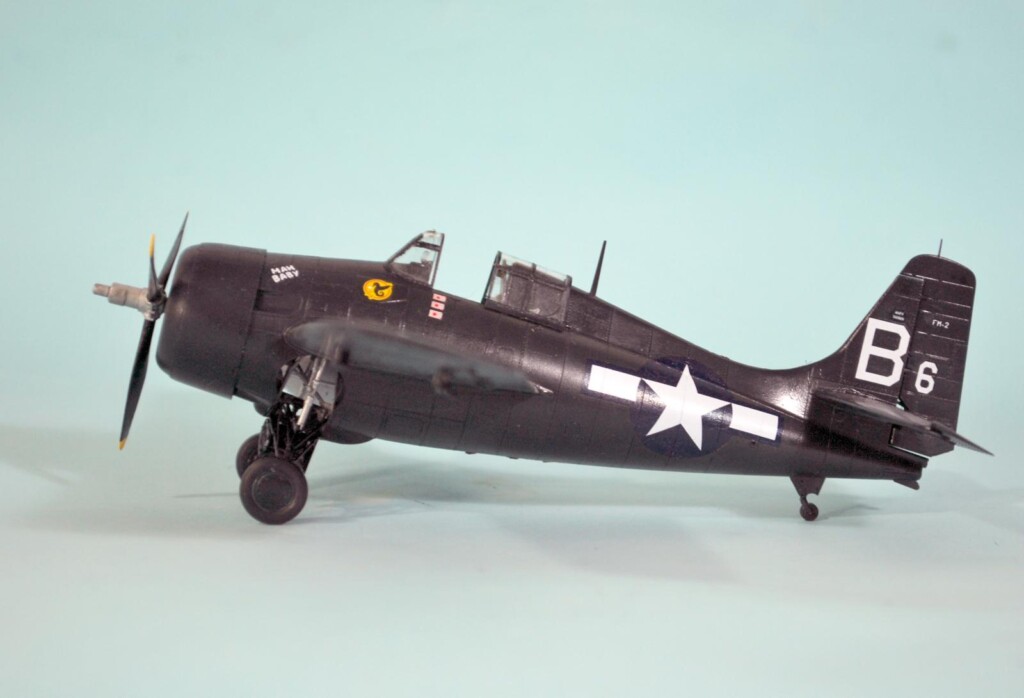
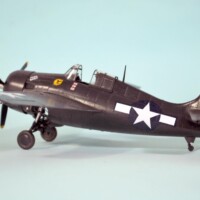
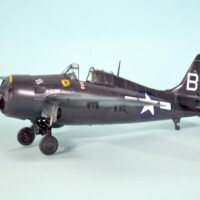
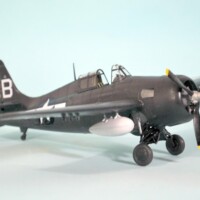
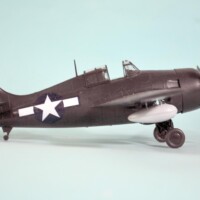
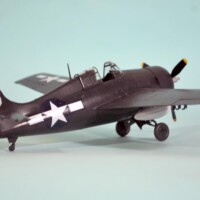
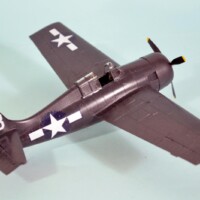
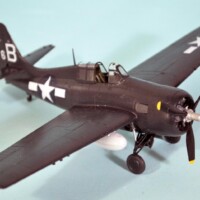
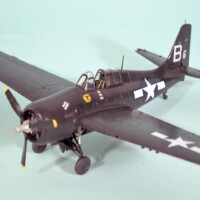
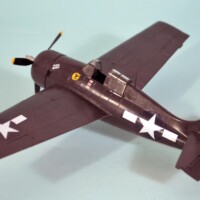
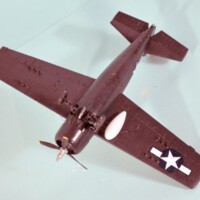
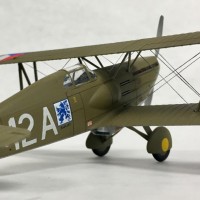

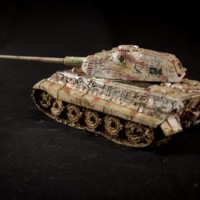
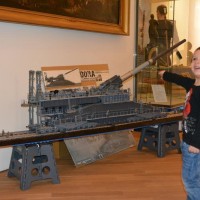
Excellent job, Tom! I really like this kit and can’t wait to start mine. I need to finish a couple of other projects first though. The paint shop isn’t keeping up with my assembly line, LOL. Thanks for sharing your experience with this one so fast.
Very informative as always Tom
Excellent job and interesting write-up. Good timing, as I'm in the middle of mine, painted the accessory/wheel well section white per instructions, then read your review at MM. Repainted the area light grey and removed the rocket stub plates. Thanks for posting this before I got too far along!
Glad to be of service, Chas.
Nice looking plane. Very good background information. P. S. - Have you read the book "The Last Stand of the Tin Can Sailors" by James D. Hornfischer? It tells the story of the Battle of Leyte Gulf, October 1944. Highly recommended.
Yeah I did. I've also written my own account (a long chapter, not a full book) in "Pacific Thunder."
Excellent result and ditto writeup, Tom!
Very nice result, Tom @tcinla
Great to look at and as always supported by a very informative and enjoyable to read to article.
Thanks for sharing all this.
Really nice job on this Tom , she looks great ,well done.
Nicely done Tom.
@tcinla - Amazing research Tom! Excellent and informative writeup and the build is really nice.
Great looking FM!
Very great work Tom.
That's a good-lookin' Wilder Cat!